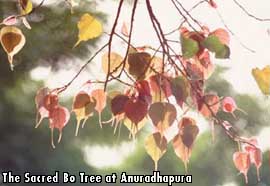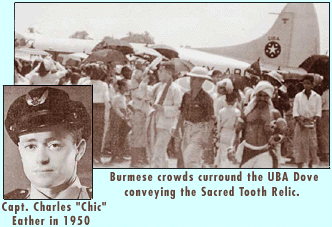 |
 16th August 1998 |
Front Page| |
 Oldest sacred symbol |
Contents
|
|
 |
In 1950 the Sacred Tooth Relic was taken to Burma. Roger Thiedeman meets the pilot who conveyed the sacred cargo The pilot and the Tooth Relic
While in Hong Kong I was privileged to meet several interesting people. Yet none more fascinating than a 78-year-old retired airline pilot with an intimate knowledge of Hong Kong and its aviation history. His long and distinguished flying career was filled with adventure, excitement and not a little danger. But this remarkable gentleman regards one of his most memorable flying experiences as the time he served as official pilot for Sri Lanka's Sacred Tooth Relic. The story begins in September 1943 when a young pilot from Sydney, Australia joined Ansett Airways as a First Officer (co-pilot). Charles 'Chic' Eather was his name. After a brief but eventful period with Ansett, in 1946 'Chic' Eather teamed up with a fledgling aviation outfit calling themselves the Roy Farrell Export-Import Company. Founded and based in Hong Kong by two former World War II pilots, Australian Sydney de Kantzow and American Roy Farrell, this small DC-3 operation later became the world-renowned Cathay Pacific Airways. Over the next few years, Charles Eather's work took him mainly to Burma (now Myanmar) where Cathay Pacific had a strong presence. He also flew for Union of Burma Airways (UBA) during the time of that nation's turbulent Karen uprising, before returning to Cathay. It was while serving with UBA that fate brought Charles Eather and the Sacred Tooth Relic together, an event he still regards with awe and gratitude nearly half a century later. Fortunately for us, Charles Eather has recorded that story in two books he wrote after he retired from flying. Recounting the early history of Cathay Pacific and the men and women who made that airline what it is today, Syd's Pirates and We Flew in Burma contain amusing, astonishing tales from places where, and a period when, commercial flying was more adventuresome by nature and less hide-bound by bureaucracy. Syd's Pirates takes its name from Syd de Kantzow, one of Cathay Pacific's founding pair, and the company's swashbuckling, rollicking aircrew of whom Charles Eather was one. More recently, Eather published his third book, Airport of the Nine Dragons Kai Tak, Kowloon, a fascinating illustrated account of aviation history in Hong Kong. But that's another story, so back to Burma and the Buddha relic ... In 1950, responding to a request from Burmese Prime Minister Thakin Nu, the Government of Ceylon agreed to send the Sacred Tooth Relic of Lord Buddha to Burma. Ceylon's magnanimous gesture would give the predominantly Buddhist Burmese a rare opportunity to worship the Buddhist world's most sacred, valued possession. This was not the first time Ceylon had sent Buddhist relics to Burma. In March 1948 the Air Ceylon DC-3 Viharamaha Devi, under the command of Captain Rex de Silva, took the Sariputta Moggalana (or Sanchi) relics, on loan from India, on a holy tour of Rangoon (now Yangon), Mandalay and Akyab. Now, in 1950, Lord Buddha's Tooth Relic would temporarily leave the shores of Ceylon where it had reposed in the sanctity and security of the Dalada Maligawa (Temple of the Tooth) in Kandy for centuries. Britain's Royal Navy provided a ship to transport the relic from Colombo to Burma, the precious cargo reaching the port of Rangoon in early March. Here, UBA and Captain Charles Eather took over. Flying a de Havilland Dove, a small twin-engine aircraft like those used by the Sri Lanka Air Force until recently, Eather had the awesome responsibility of conveying the relic in safety and dignity across the skies of Burma. On 4 March, the UBA Dove left Rangoon for Mergui, in the south of the country, the Sacred Tooth Relic in its casket ensconced aboard, and 'Chic' Eather at the controls. Two days later, he took it north to the town of Tavoy. Everywhere they went, Eather was impressed by the effect the Holy Tooth had on the Burmese people. He feared for the safety of devotees who rushed the arriving Dove even before its propellers had stopped spinning. In one of his books, Eather tells how "the crush of worshippers who came to greet the sacred relics was outside anything in my experience, or my imagination. The reverence they displayed towards that golden-domed container was deep, pervasive, unbelievable and I, being its custodian, was looked upon with something akin to hero-worship and rapture. I felt the responsibility. I considered all manner of calamitous accidents. I shook for days afterwards, for much of the flight was across the restless Gulf of Martaban, and the loss of the aircraft would have entailed the loss, not only of the sacred relics which were beyond price, but also the co-operation and goodwill of millions of followers of Buddha." Charles Eather was equally fascinated by the team of twenty Kandyan dancers and drummers who had accompanied the Sacred Tooth Relic on its journey to Burma. Each day at 11 a.m. they performed what he describes as "the customary ceremonies of reverence which had been maintained for 2000 years, offering tokens of water and flowers." Marvelling at the dancers' virility and grace, their glorious spectacle and ability to whirl and reverse, to advance and retreat to the beat of tom-toms, Eather easily understood why that great ballerina Anna Pavlova "had rated Kandyan dancing more highly than anything else in the world." But, for Charles 'Chic' Eather, the highlight of that tour came in mid-air. During one of the flights he was permitted the rare privilege of holding the gilt casket and actually looking at the Sacred Tooth. It was a humbling experience for this young Australian who, in his own words, "was neither prince nor Buddhist". To this day he treasures the memory as one of the greatest moments of his life. Later, after Captain Eather rejoined Cathay Pacific Airways, he married Judy Hui, a pretty air hostess of Chinese origin. Having logged over 25,000 flying hours, including captaincy on Convair 880 and Boeing 707 jetliners, Charles Eather retired from Cathay Pacific in 1975, aged 55. Together with Judy and their two children, he moved from Hong Kong to the sunny Gold Coast in Queensland, Australia, where they continue to reside. On that June Sunday on the eve of Kai Tak airport's closure, when I met 'Chic' Eather for lunch at the Kowloon Cricket Club, I was both fascinated and surprised. Fascinated by the tales he told of his flying days, the stories he could not cram into his books. And surprised to discover that this pilot of yesteryear, one of 'Syd's Pirates', is a man of sober and pious habits. Belying the worldliness of his former profession, Charles Eather revealed himself to be a teetotaller, a nonsmoker, and a devout, practising Christian. Even more admirable is his respect for all other religions and their adherents. Afterwards, as we bade farewell to each other on busy Nathan Road in Kowloon, I mused that Charles Eather's easy-going demeanour and his tolerance for all religious beliefs must stem, at least partially, from his close encounter with Lord Buddha's Sacred Tooth Relic in those far-away Burma days.
More Plus * India: realising the two extremes
Front Page| News/Comment| Editorial/Opinion| Business| Sports | Mirror Magazine |
|
 |
Please send your comments and suggestions on this web site to |
|
 During
the last weekend in June, like many other aviation enthusiasts from all
over the world, I made a final 'pilgrimage' to Kai Tak airport, Hong Kong.
Regular Sunday Times readers may recall my fascination for that unique,
now-defunct airfield, as expressed in the article "Farewell to Kai
Tak" on Sunday July 5.
During
the last weekend in June, like many other aviation enthusiasts from all
over the world, I made a final 'pilgrimage' to Kai Tak airport, Hong Kong.
Regular Sunday Times readers may recall my fascination for that unique,
now-defunct airfield, as expressed in the article "Farewell to Kai
Tak" on Sunday July 5.